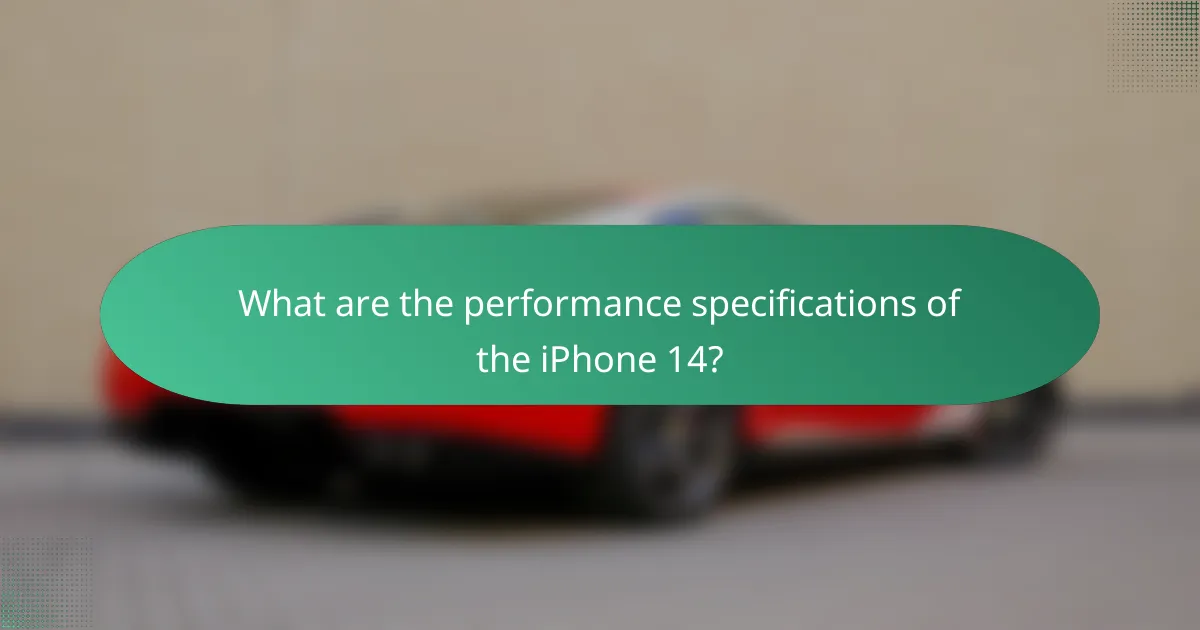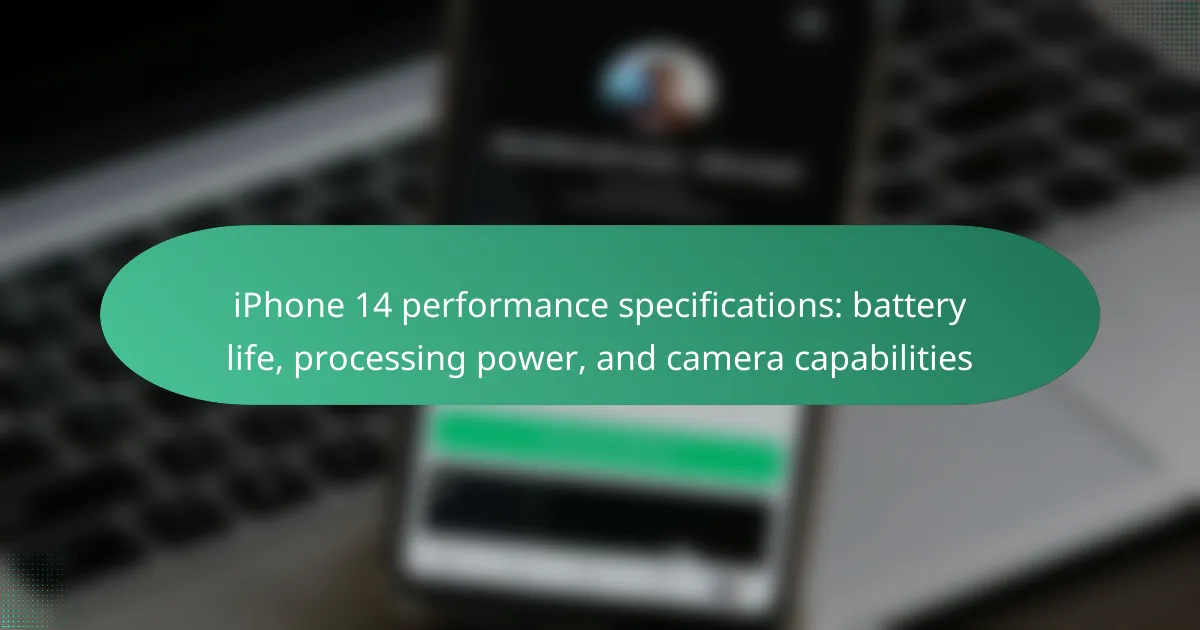The iPhone 14 is equipped with the A15 Bionic chip, featuring a 6-core CPU and a 4-core GPU, delivering robust processing power. This device supports 5G connectivity, enabling faster data speeds, and offers an impressive battery life of up to 20 hours of talk time. Additionally, the iPhone 14 includes advanced charging options such as MagSafe and wireless charging. Its camera system boasts a dual 12 MP configuration, enhanced by Night mode for improved low-light photography, and supports 4K video recording at 60 frames per second.

What are the performance specifications of the iPhone 14?
The iPhone 14 features the A15 Bionic chip, ensuring high processing power. It includes a 6-core CPU and a 4-core GPU. The device offers 5G connectivity for faster data speeds. The battery life lasts up to 20 hours of talk time. It supports MagSafe charging and wireless charging options. The camera system includes a dual 12 MP setup for high-quality photos. Night mode enhances low-light photography capabilities. The device also supports 4K video recording at 60 fps.
How does the iPhone 14’s battery life compare to previous models?
The iPhone 14’s battery life is improved compared to previous models. It offers up to 20 hours of talk time. This is an increase from the iPhone 13, which provided up to 19 hours. The iPhone 14 also supports up to 80 hours of audio playback. In contrast, the iPhone 13 supported 75 hours. The battery capacity of the iPhone 14 is 3279 mAh, while the iPhone 13 had a capacity of 3240 mAh. These enhancements indicate a notable advancement in battery performance.
What is the estimated battery life for different usage scenarios?
The estimated battery life for the iPhone 14 varies by usage scenario. For typical use, it lasts up to 20 hours. In video playback, it can reach around 17 hours. For audio playback, the battery life extends to approximately 75 hours. When using 5G, the battery may deplete faster, affecting overall longevity. These estimates are based on Apple’s testing under specific conditions. Real-world usage may vary depending on settings and applications.
What factors influence the battery performance of the iPhone 14?
Battery performance of the iPhone 14 is influenced by several factors. These include battery capacity, software optimization, and usage patterns. The iPhone 14 has a battery capacity of 3279 mAh. This capacity directly impacts how long the device can operate on a single charge. Software optimization, such as iOS updates, enhances power management. Efficient app usage also plays a role in battery drain. Background processes and screen brightness settings can affect overall battery life. Environmental conditions, like temperature, further influence battery performance. Each of these factors contributes to the overall efficiency and longevity of the iPhone 14’s battery.
What processing power does the iPhone 14 offer?
The iPhone 14 is powered by the A15 Bionic chip. This chip features a 6-core CPU, which includes 2 performance cores and 4 efficiency cores. Additionally, it has a 4-core GPU for enhanced graphics performance. The A15 Bionic chip also includes a 16-core Neural Engine for advanced machine learning tasks. This processing power allows the iPhone 14 to handle demanding applications and multitasking efficiently. The A15 Bionic chip is known for its energy efficiency, contributing to improved battery life. Overall, the iPhone 14’s processing power supports high performance in gaming, photography, and other resource-intensive tasks.
What chip is used in the iPhone 14 and what are its capabilities?
The iPhone 14 uses the A15 Bionic chip. This chip features a 6-core CPU with 2 performance and 4 efficiency cores. It has a 4-core GPU, enhancing graphics performance. The A15 Bionic chip includes a 16-core Neural Engine for advanced machine learning tasks. It supports 5G connectivity for faster network speeds. The chip also improves battery efficiency, extending usage time. Additionally, it enhances image processing for better camera capabilities. Overall, the A15 Bionic chip significantly boosts processing power and efficiency in the iPhone 14.
How does the processing power impact overall device performance?
Processing power significantly impacts overall device performance. It determines how quickly and efficiently a device can execute tasks. Higher processing power leads to faster application loading times. It also enhances multitasking capabilities, allowing users to run multiple apps simultaneously without lag. Additionally, improved processing power can boost graphics performance, enhancing gaming and media experiences. Devices with strong processors typically perform better in complex operations, such as video editing or 3D rendering. For instance, the iPhone 14 features the A15 Bionic chip, which provides advanced computational capabilities. This chip enhances the device’s speed and efficiency, contributing to a smoother user experience.
What are the camera capabilities of the iPhone 14?
The iPhone 14 features advanced camera capabilities. It includes a dual-camera system with a 12 MP wide and a 12 MP ultra-wide lens. The wide lens has an f/1.5 aperture for improved low-light performance. The ultra-wide lens captures a 120-degree field of view. The camera system supports Night mode for enhanced low-light photography. It also includes Photonic Engine for better color and detail in images. The iPhone 14 can record 4K video at up to 60 fps. Additionally, it offers Cinematic mode for professional-looking video depth effects. These capabilities make the iPhone 14 a powerful tool for photography and videography.
What features are included in the iPhone 14’s camera system?
The iPhone 14’s camera system includes a dual-camera setup with 12 MP ultra-wide and wide lenses. The ultra-wide lens has a 120-degree field of view. The wide lens features an f/1.5 aperture for improved low-light performance. Night mode is available for both lenses, enhancing photos in dark conditions. Photonic Engine technology improves image processing for better detail and color. The camera system supports 4K Dolby Vision HDR recording. It also includes advanced computational photography features like Smart HDR 4. Additionally, there is a Cinematic mode for video recording with shallow depth of field.
How do the camera specifications enhance photo and video quality?
Camera specifications enhance photo and video quality through features like resolution, lens quality, and sensor size. Higher resolution, such as 12 MP or more, allows for greater detail in images. Advanced lens technology reduces distortion and improves clarity. A larger sensor size captures more light, resulting in better performance in low-light conditions. Optical image stabilization minimizes blurriness in videos and photos. Enhanced autofocus systems ensure sharp images by quickly locking onto subjects. Additionally, features like HDR (High Dynamic Range) improve color accuracy and contrast. These specifications collectively contribute to superior overall image and video quality.
How do battery life, processing power, and camera capabilities interrelate?
Battery life, processing power, and camera capabilities are interrelated in smartphones like the iPhone 14. Higher processing power typically requires more energy, which can reduce battery life. The camera’s advanced features, such as high-resolution imaging and video recording, also demand significant processing power and energy. For instance, using features like Night mode or 4K video recording can quickly drain the battery. Conversely, efficient battery management allows sustained processing power for demanding camera tasks. The iPhone 14 balances these aspects with its A15 Bionic chip, optimizing performance while maintaining battery efficiency. This integration ensures that users can utilize high-quality camera features without excessively compromising battery life.
What practical tips can enhance the performance of the iPhone 14?
To enhance the performance of the iPhone 14, users can implement several practical tips. First, keep the iOS updated to benefit from performance improvements. Regular updates optimize system efficiency and fix bugs. Second, manage background app refresh settings. Disabling this feature for non-essential apps can conserve resources. Third, reduce visual effects by enabling “Reduce Motion” in settings. This decreases the load on the processor. Fourth, clear unused apps and data. Regularly deleting unnecessary files improves storage management. Fifth, enable Low Power Mode when battery life is critical. This feature limits background activity and extends usage time. Lastly, avoid extreme temperatures. Operating the device within recommended temperature ranges maintains optimal performance. These tips collectively help maintain and enhance the iPhone 14’s performance.
The iPhone 14 is a high-performance smartphone characterized by its advanced battery life, processing power, and camera capabilities. It features the A15 Bionic chip, which includes a 6-core CPU and a 4-core GPU, providing efficient multitasking and gaming experiences. The device boasts an improved battery life of up to 20 hours of talk time and advanced camera specifications, including a dual 12 MP system with Night mode and 4K video recording. This article will explore the specifications and interrelations of these key features, along with practical tips to enhance the iPhone 14’s performance.
